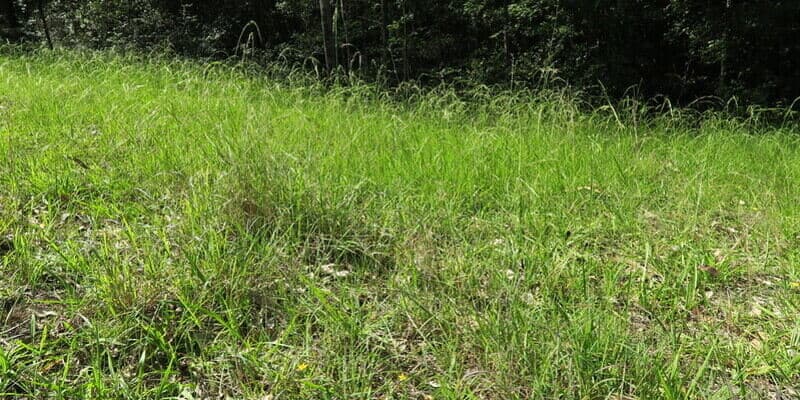How many times have you looked at that dry, shady spot in your garden that feels a bit empty?
Maybe you’ve got a dense, wide tree that blocks out some light. Or maybe you want some border plants along the side of your house.
That’s where you look for shade-loving flora – and what better to choose than Australian native plants for dry shade? That way, they’re perfectly adapted to your local environment.
These shrubs, trees, and other plants will grow just fine in dry, shady conditions, letting you create a hardy and versatile landscape. No more empty spaces in the shade – it’s time to fill up your garden!
Levels of Garden Shade | General Native Plants | Flowering Plants | Native Grasses
Dry Shade vs Wet Shade

The terms “dry shade” and “wet shade” describe the growing conditions in the shaded area of your garden!
“Dry shade” means the area has dry conditions – typically soil that doesn’t retain moisture well or doesn’t get much natural wetness. Humidity levels will also likely be low.
On the other hand, “wet shade” indicates damp conditions – rich, moist soil that doesn’t dry out completely or is near a water source. These areas tend to have high humidity.
“Wet shade” spots typically see a lot of pooling or standing water (like a low point in the garden), or poor soil drainage.
Levels of Garden Shade
There are different types or levels of shade in a garden, which you’ll see in many descriptions of outdoor plants.
These levels of shade are used to describe the amount of sunlight an area receives in a day.
Besides “shade-loving,” you’ll often see the word “understory” used to describe plants that grow in shady areas. This means they can be grown underneath taller, denser plants.
Full shade
Think of a spot beneath a tree with dense foliage or under the eaves of a house. “Full shade” means the area receives no more than 4 hours of sun throughout the day, all year round.
It doesn’t mean no sun at all, though! No plant can subsist on zero hours of sunlight… well, except for some funky mushrooms.
Partial shade

“Partial shade” and “partial sun” both mean a spot that gets between 4-6 hours of sunlight in a day.
The difference is in the words “sun” and “shade” – a plant that does well in partial sun will prefer more exposure (closer to 6 hours).
On the other hand, a plant in “part shade” can thrive even with less exposure (closer to 4 hours).
Areas that get “part shade” may have a tree or structure blocking the sunlight for several hours a day, either morning or afternoon.
Dappled shade
This term isn’t as common, but is usually used to describe a spot where sunlight filters through foliage or structures throughout the day.
Imagine a spot under a tree with patches of sunshine here and there. That’s “dappled” light!
You’ll usually see dappled shade in early spring, when deciduous trees are still filling out their canopies. The sunlight can filter through the sparse leaves and reach the ground below.
Native Australian Plants for Dry Shade
These Australian natives are perfect to grow in fully-shaded or partly-shaded garden spaces.
From trees to ferns, here are our gardeners’ top picks for shade-loving plants to grow in your yards.
Acacia cognata ‘River Wattle’

Acacia cognata (bower wattle or river wattle) is a small tree native to NSW and Victoria. Unlike other wattle varieties, the river wattle has a weeping habit, giving it a unique look in any garden.
River wattles aren’t fussy about soil type, but they do prefer milder climates and protection from wind. This shrub does just fine in semi-shade, so you can grow it under other trees
A. cognata is drought-tolerant, so it does fine in dry, shaded conditions, but it’ll need extra watering during the hotter months.
Fun fact: Many dwarf wattles are A. cognata cultivars!
Bird’s Nest fern

Ferns are hardy and forgiving plants, able to tolerate a range of conditions – and the Asplenium australasicum is no exception.
The bird’s nest fern makes a dramatic statement in any garden thanks to the large fronds growing in a nest shape. You can grow it in well-drained soil in the ground or a pot!
Bird’s nest ferns are great Australian native plants for under trees or by fences, since they’re “understory” plants and can survive even in heavy shade.
Water A. australasicum well while it’s young, but the plant is drought-tolerant once established.
Native frangipani ‘Gold Nugget’

The Gold Nugget is a dwarf cultivar of the Hymenosporum flavum or native frangipani, an Australian native tree. This compact, evergreen shrub puts out starry cream-to-yellow flowers in spring.
Since it reaches only 1m in height, the Gold Nugget frangipani is perfect for small gardens or balconies. It also makes a great border plant alongside fences or paths.
Gold Nugget frangipanis grow just fine as shade plants, but will need more sun if you want the most flowers.
Soft tree fern

Don’t let the name fool you – the soft tree fern (Dicksonia antarctica) is a hardy fern that can tolerate even poor soils and heavy shade.
Soft tree ferns generally prefer moist soil, but they can survive in dry conditions. Just make sure you don’t let the plants completely dry out for prolonged periods.
Layering organic mulch around the fern can help retain moisture.
The fibrous trunk of a soft tree fern is actually decayed organic matter – it’s not “alive,” just a medium from which the fronds grow. If you cut into the trunk, it won’t regenerate or grow new fronds.
Flowering Australian Native Shade Plants
Flowering plants usually need direct sunlight, but there are some that will bloom even in shady areas!
These Australian native flowers will add colour to the less sunny areas of your garden.
Branching grass flag

Libertia paniculata is actually a rainforest perennial plant, but it can adapt to dry conditions! Just make sure you water it regularly during hot or dry months.
The branching grass flag likes semi-shaded areas with well-drained soil. This clumping, grass-like plant grows to about 0.5m high and can tolerate being cut back hard.
L. paniculata puts out starry white flowers in spring. Deadhead the plant and trim the foliage after flowering to maintain a neat appearance.
Heart-leaf flame pea

If you’re looking for Western Australian native plants for shade, check out the heart-leaf flame pea! You’ll see a lot of its orange-and-purple flowers in southwest WA in early spring.
Those vibrant, pea-shaped blooms give the flame pea its name. The most commonly grown variety is Chorizema cordatum, but you can also get C. ilicifolium and C. varium.
Flame pea plants like dry climates with mild humidity. They grow best in shaded areas since the flowers are susceptible to scorching or sunburn in full sun.
Native violet

Viola banksii is a hardy plant that thrives in plenty of shade. As its name suggests, the native violet puts out violet-and-white flowers throughout the year.
Native violets love well-draining soil, but can adapt to all sorts of ground conditions. They’re even salt tolerant, so you can grow V. banksii in coastal gardens.
The native violet is generally low-maintenance but will need more moisture during warmer months. You can grow it as ground cover or as a feature in hanging pots.
NOTE: Make sure you’re getting the V. banksii plant! Some other Viola plants (such as V. hederacea and V. odorata) can be invasive outside their native regions.
Kangaroo lobelia

Dampiera diversifolia, often known as Dampiera or Kangaroo Lobelia, is another native flowering plant that can grow in shaded areas.
Expect masses of deep blue or purple flowers from September to December. With a low-growing habit, you can even use it as ground cover – imagine a carpet of gorgeous blooms in spring!
Kangaroo lobelia plants like free-draining soil in part shade or dappled sunshine. Be mindful of suckering (new growth from far-reaching roots) as D. diversifolia can spread quickly!
Australian Native Grasses for Dry Shade
Native grasses are excellent alternatives for your lawn!
They’re well-adapted to your local environment and growing conditions, and are generally low-maintenance.
Blue flax lily

Despite the name, the Blue flax lily (Dianella longifolia) is actually a native grass that grows in a variety of conditions.
It’s also called Blueberry lily for the berries produced in summer – which are edible!
Dianella grasses are drought-hardy and grow just fine in part shade. They’ll thrive in most climates except tropical, and they’re even salt-tolerant.
Blue flax lily grass can reach 0.9m in height but can be cut back hard, since it regrows from underground rhizomes.
Mat rush

Known as mat rush or basket grass, Lomandra longifolia is a hardy and versatile native grass that can tolerate many conditions.
Native lomandra is fast-growing, reaching 1m in height if not regularly mowed or trimmed.
It thrives even in part shade, so it can cover parts of your lawn that are under dense trees or structures.
Mat rush is also drought-tolerant and can grow even in arid climates. In spring, it puts out yellow flower spikes.
Swamp foxtail grass

Pennisetum alopecuroides is a pretty showy, clumping native grass! It has arching, variegated leaves that are topped with fluffy, purple-ish flowers in summer.
Swamp foxtail grass is best planted in clumps as a garden accent.
It grows fine in dry, sandy soils and partial shade – but this hardy grass will tolerate just about any conditions, from frost to drought.
Look for the Ozbreed cultivar, Pennstripe™, since it’s not self-seeding and so will not spread. Otherwise, deadhead P. alopecuroides flowers before they go to seed.
NOTE: Make sure you get the native Australian Pennisetum and not the invasive African Pennisetum.
Weeping Rice-grass

Microlaena stipoides is known as Weeping Rice-grass or Meadow Rice-grass. When it comes to grasses, it’s one of the best Australian natives that like shade.
Weeping Rice-grass has dense growth that requires little water once established. It can grow anywhere in your garden, even partially shaded areas – it’s often found in shady bushlands in the wild.
However, like other native grasses, Weeping Rice-grass isn’t tolerant of high foot traffic.
Avoid it if you have pets since it’s susceptible to damage from dog urine and may cause skin irritation in pets.
Tips for Maintaining Shade-Tolerant Plants
When planting and caring for shade-tolerant native plants, make sure you learn their growing conditions!
Some can tolerate shady, dry areas with a bit more care (like more frequent watering). Others are very low-maintenance and can be left to themselves.
Choose the right time to plant your shade-loving Australian natives so they can establish their roots properly. If you’re unsure, tag in some expert local gardeners to help with planting and care.
And of course, remember that “shade” doesn’t mean “zero sun.” Even full-shade-loving plants need a few hours of light every day – you wouldn’t be happy with no sunshine, either!

